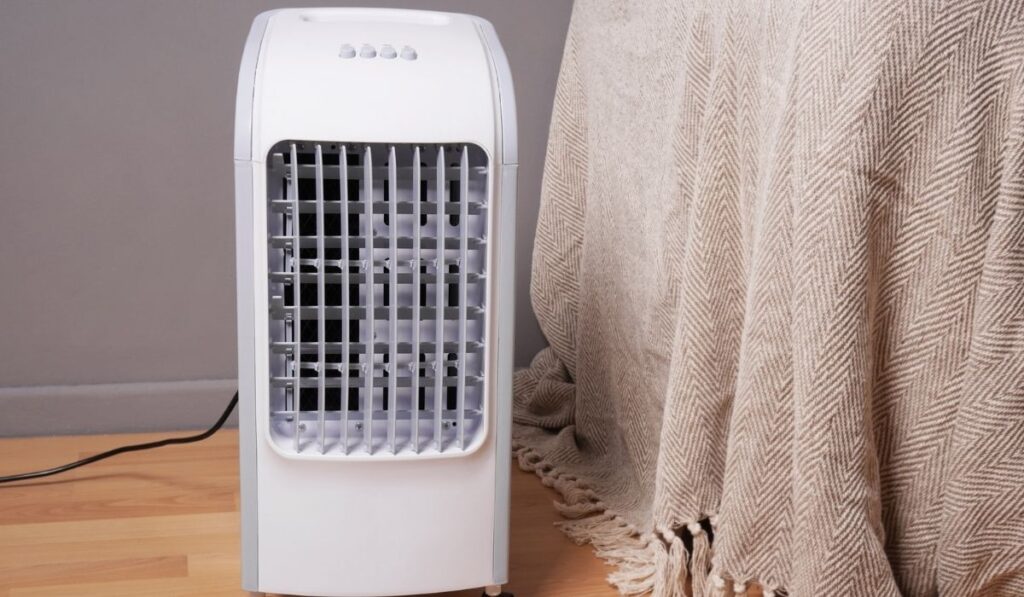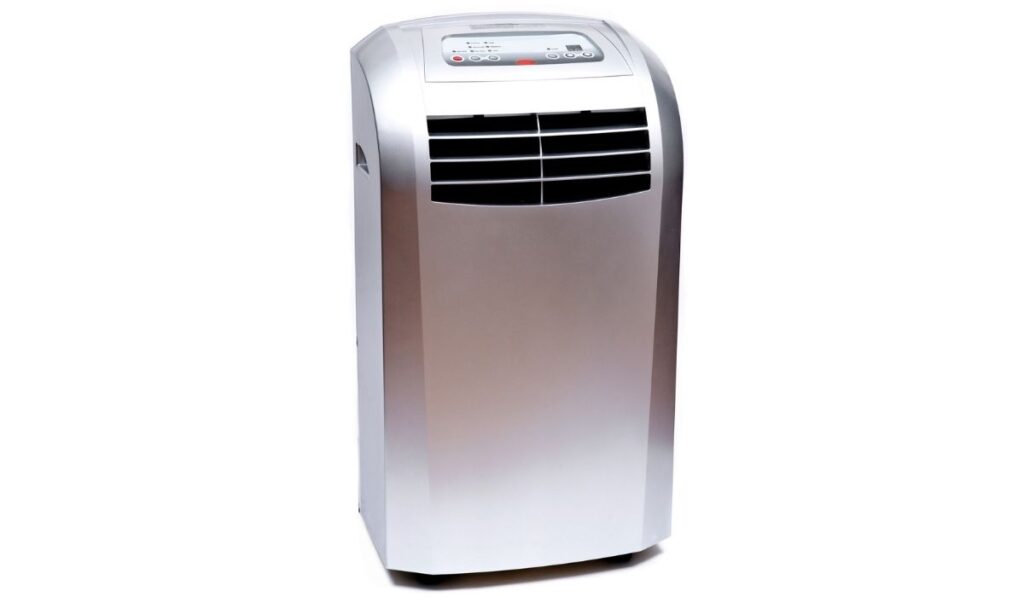It’s a clue that something is wrong with your air conditioner if it’s on but not blowing cool air. Clogged air filters, low refrigerant levels, malfunctioning temperature sensors, or improper space sizing are reasons why a portable air conditioner might not be cooling.
To fix a portable AC that isn’t cooling, first try cleaning the filters, which may be clogged, and make sure your unit is powerful enough for its space. There’s also possible a Freon leak or a faulty thermostat sensor; these issues may require professional attention.
While some repairs are simple to perform on your own, you may want to have a specialist on hand to assist with more sophisticated issues.
Why Is Your Portable AC Running but Not Cooling?

A portable air conditioner (on Amazon) may fail to cool down space for various reasons. The most typical culprit is refrigerant leakage, although clogged filters, a broken thermostat, and a too-large room are other potential concerns to investigate.
Here are some potential reasons why your portable air conditioner isn’t working properly:
Clogged Air Filter
Your portable air conditioner collects dust and other particles in the air to keep it clean for you to breathe. These particles are filtered utilizing the unit’s air filters. However, if debris and dirt particles accumulate, the air filters become clogged, and the air conditioner fails to do its job.
Because of the disrupted circulation, the portable air conditioner no longer efficiently cools. When the unit is turned on, the fan may function, but there may be no free flow of cold air in the room. This happens if you leave the air conditioner on without cleaning the filters, and the system gets drained.
Low Freon Level
When your air conditioner is operating properly, it contains Freon, a refrigerant gas responsible for your air conditioner creating chilly air. Your portable air conditioner may not be cooling due to a shortage of Freon refrigerant.
A simple solution is to repair the leak and recharge the air conditioner. However, it’s best not to do this yourself because it takes some expertise to ensure that the appropriate amount of Freon is replaced. The air conditioner will still have issues if there’s too much or too little Freon.
Faulty Thermostat Sensor
A malfunctioning temperature sensor might cause inconsistent operation of a portable air conditioner. The device may spew out warm air, or the compressor may suddenly stop and fail to chill the space in certain situations.
If the air conditioner can’t detect the room temperature accurately, it won’t work correctly and may send out warm air when it should blow out cold air.
Incorrect Sizing
An air conditioner’s size relates to its cooling power, measured in British Thermal Units, or BTU. If your portable air conditioner is not sufficiently cooling the space, the issue might be that the unit isn’t the right size.
A portable air conditioner placed in a room larger than its cooling capacity will not appropriately regulate the temperature. In this case, the AC is not mechanically faulty. It’s just a mismatch between BTU and room size.
How to Fix a Portable AC Unit That’s Not Blowing Cold Air
Clean the Filters
Your portable air conditioner’s filters collect dust, mold, lint, pet dander, and other particles.
If you have a washable filter air conditioner:
- Remove the filter from the frame
- Shake it to remove any dust and debris
- Clean it well with warm water and a little detergent
- Let the excess water run out and dry before reinstalling
Match the BTU to Room Size
After determining that the portable air conditioner is operating and blowing cold air but not chilling the area, you’ll realize that there’s a mismatch in BTU-room size.
- Assess the square footage of the room where the portable AC is being used
- Use a BTU size chart to determine whether the unit is overloaded.
- Use the air conditioner in a smaller location while acquiring a larger BTU unit to cool larger spaces.
Keep in mind that the square footage of your room is not the sole consideration in determining the BTU rating. Other considerations include the quantity of shade or sunlight, the presence of a kitchen, and the number of people that utilize the area.
Recharge the Freon
Whether portable or window units, the refrigerant in most air conditioners is designed to last as long as the device does. If it becomes exhausted, there is probably a leak in the system. To resolve the cooling issue, repair the leak and then replenish the refrigerant with the manufacturer’s suggested Freon.
Some portable air conditioner recharge kits are available for this purpose. If you’re unsure what to do, a repair professional should be able to assist you with the recharge.
Fix the Temperature Sensor
A faulty thermostat implies that the air conditioner won’t detect temperature changes and therefore won’t know when to switch on or off. Most air conditioners have a thermostat near the evaporator coils that senses the temperature and controls whether the air conditioner cools or heats the area.
- Check whether the temperature sensor is damaged or out of place before beginning a repair.
- Hire a local HVAC repair technician to assist you in removing and replacing the thermostat if you’re unable to do it yourself.
- Check if you have a limited or lifetime warranty on your air conditioner before trying any repairs. You should also disclose this to your repair expert to avoid voiding your warranty.
How to Make a Portable Air Conditioner Colder
When your home or workplace air conditioner has broken down or isn’t up to keeping you cool, leasing a portable air conditioner is a terrific choice. These self-contained cooling systems are easy to use, portable, and cost-effective cooling.
Here are some ways to maximize the cooling of your portable AC:
Keep the Hose Straight
The exhaust hose aims to transport heated air out of the space, whether via a window, door, or drop ceiling. The hose should be straight and devoid of kinks and bends for best performance.
A twisted hose prevents warm air from being appropriately withdrawn, forcing the unit to work more to deliver enough cooling.
Furthermore, moisture from the evacuated air will collect in the hose and eventually harm the machine, reducing its service life.
Close All Doors and Windows.
All doors and windows must be closed to guarantee that your portable air conditioner operates appropriately. This will prevent warm air from entering and cool air from departing from the inside.
Open doors and windows put a strain on your portable unit. It would be beneficial if you additionally covered windows with available drapes and shades. This is done for two reasons:
- To cover the air conditioner from direct sunlight
- To prevent heat from entering the room
Turn on the AC before You Need It
Start the air conditioner before your team comes or if you intend to use a room. The goal is to maximize cooling while keeping everyone comfortable. When you switch on your portable air conditioner in the morning when the temperatures are lower, it will consume less electricity to chill the room.
Try not to wait until a room has reached the temperature of a furnace before turning on the air conditioner.
How Can You Make Your Portable Air Conditioner Work Better?

Here are some tips on how you can make your portable AC work better:
1. Use a Window Sealing Kit
Portable air conditioners are always equipped with an exhaust line that leads to the outdoors. Install the drain hose with a window sealing kit (on Amazon) to ensure that the portable air conditioner works correctly. This type of gear aids in keeping heated air out.
Proper window sealing reduces the air conditioner’s temperature loss. Check the product handbook for instructions on effectively attaching the window sealing kit. This information may be found on the product page of your portable air conditioner or the sealing kit.
2. Place the AC in the Proper Location.
Locate your AC near a window so that the hose can run through it. A sliding or tilted window works better with such a hose than a slanted roof window with a hinge in the center. A warm air opening is always present in such a window.
Check that the air conditioner is not too close to the wall and that nothing is on top. Items placed on top of the air conditioner reduce air circulation. Check that nothing is on top of the air conditioner and that it is not too near the wall. Air circulation is reduced when items are put on the air conditioner.
3. Cool the Room Before It Gets Too Hot
It takes a lot of energy to return a heated space to a comfortable temperature. That’s why it’s more beneficial to have a moderately cold environment. If the portable air conditioner needs to maintain a comfortable temperature, it will use less electricity.
4. Heat Protection for the Room
Using any available window shades, curtains, or other window coverings to keep the space from heating up owing to outside forces. It is beneficial to protect the room from direct sunlight exposure. Make sure that all windows and doors are shut to keep heated air from the outside from entering the room.
5. Place the AC in a Room That Isn’t Too Huge
Every air conditioner has a maximum area that it can cool. We distinguish between high and low heat loads. Heat loads are higher in a room with a lot of daylight and minimal insulation than in a dark, isolated space.
You won’t be able to chill the entire area if you use a portable air conditioner in a bigger space than recommended. The gadget then merely produces noise and fails to achieve the appropriate temperature.
6. Limit Use of Electrical Equipment
When you use a lot of other cooling equipment in the room, it impacts your air conditioner’s effectiveness. To some extent, electronic equipment generates heat. Your vacuum is an excellent example of this. Because a vacuum produces a lot of hot air, it’s best to avoid using it on a hot day. By reducing heat sources, the air conditioner’s cooling capability will be optimized.
